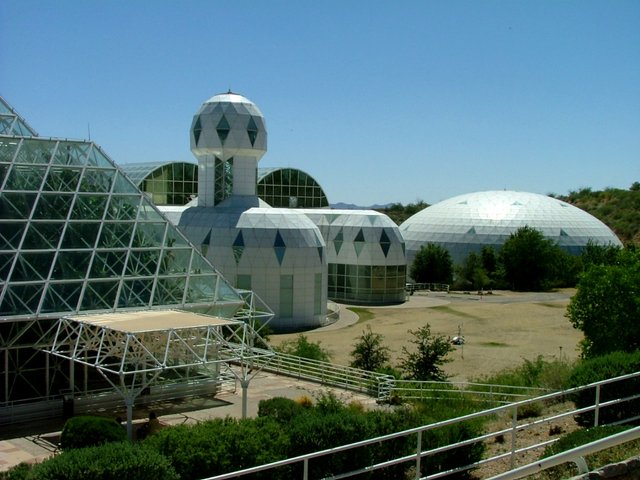Biosphere 2 - Lessons In Space Habitation

For the first time in our history, the drive to become a multi-planet species can be estimated with some degree of credibility.
Based on our collective desire to colonise another planet, available technology, and planned missions. It is not unreasonable to expect that we will have some sort of off-world colony within the next fifty years.
Whether it is our own moon, Mars, or even the planet Venus that we first attempt to colonise, we will need to live in constructed habitats containing atmospheres that can sustain a wide variety of life.
The key requirements for these future planetary habitats, is that unlike the International Space Station, they will have to be self-contained, needing no outside help for their continued survival.
One of the first and most obvious problems these future habitats encounter, is the fact that we don't know exactly how they'll work until we actually start building them. Making disaster planning extremely difficult, if not completely impossible.
So why aren't we building space habitats on earth, where we can safely test them?
Well there was one such habitat that was built right here on earth. Biosphere 2, built in Oracle, Arizona, was and is to date, the largest ever experiment of its kind.
What Was Biosphere 2?
As Bill Dempster the Director of Engineering, and one of the original crew members of the Biosphere 2 project states:
"[...]it was never envisioned there would be immediate applications [for Biosphere 2]. Rather, the facility was seen as a start in building experience in how to miniaturize portions of Earth's biosphere."
The idea behind Biosphere 2 was to study the earth's ecology within a controlled environment. The hope was that they learned things about our ecosystem that contribute to conserving our ecology.
However Biosphere 2 was the largest closed-system experiment in history, which means that regardless of the program directors' original motivations, the data gathered is of great interest to the organisations interested in starting off-world colonies.
The experiment included many plants, insects, animals, and eight humans. The idea was to lock everything inside a sealed, airtight biodome for two years. The original experiment lasted from September 26th 1991 to September 26th 1993. A second one was started in 1994, however after ten months the new owners decided that they wanted to go a different route. Thus the experiment, along with the whole close-system program, was ended.
The Learning Curve
Even though the experiment was carried out to find unknown answers to questions, and even to discover new questions. The way it was reported on did not reflect that Biosphere 2 was a fact finding mission. More so it was reported as a failure with few successes.
Quite rightly the original team were upset by this, as Dempster states in his letter;
"The press treated Biosphere 2 like a competition where success and failure was only judged by the degree of its material closure. If all the answers were known [beforehand], Biosphere 2 would have been a demonstration, not an experiment..."
One of the things the team learned is that the concrete used to construct part of the building, absorbed way more oxygen than they realised. This meant that more had to be pumped in, in order for the human inhabitants to survive.
The Biosphere 2 team also experienced social strain amongst the eight crew members. Even though they (contrary to popular reports) carried on working together harmoniously, the experiment showed the importance of being part of a large social group when living in isolation.
Food production is obviously a key element of a self-sustaining habitat. Indeed according to Dempster the Bioshpere farmland was a tremendous success, he stated:
"Biosphere 2's farm was the most productive half acre of farmland ever – and recycled its nutrients and water, maintained soil fertility without chemical fertilizers or any toxic chemicals.
The second closure experiment in 1994 [the biosphere crew] achieved 100% food sufficiency because of improvements and lessons learned by the first crew."
Waste Not Want Not
Biosphere 2 was all about understanding how earth's ecology sustains itself using many complex recycling systems. From the carbon cycle to the water cycle, everything on earth is used and reused over and over again. For instance in every glass of water you drink, you are ingesting at least one molecule that past through the kidneys of Julius Caesar. In fact some of the carbon molecules that were in a tyrannosaurus-rex a few hundred million years ago are sitting in you right now.
It is this kind of efficiency that the Biosphere 2 team were attempting to recreate on a small scale. They learned that it was very difficult and extremely expensive to do so, but they also learned that it is possible.
As mentioned above Biosphere 2 was taken over in the mid-nineties by Columbia University. After they took over they decided to focus on more conventional, but worthwhile, ecosystem level experiment.
Columbia ended Biosphere 2's use as a closed ecological system, along with human habitation. Although it remains open today, it has deviated from its original purpose.
Hopefully the data collected during those two amazing experiments will continue to be useful now and in the future as we look to recreate this experiment on another planet.
Perhaps too, NASA and the other government and private space industries will see the value in what was achieved in Biosphere 2, and will reignite either the original program, or start up a new one like it.
Because the main thing we learned from this experiment, was that recreating the delicate, yet robust balancing act our atmosphere produces for us is very hard.
By the way, in case you're wondering why it was called Biosphere 2, is because Biosphere 1 has already been claimed; by the earth.
Sources
Setting the Record Straight About the Biosphere 2 - Brian Dempster letter, Motherboard/vice
Further Reading - Jilted Moon Series:
Luna, The Jilted Wife: Leaving The Moon For Mars
SHOULD WE SPARK THE BIOSPHERE PROGRAM OR SIMILAR BACK INTO LIFE? DOES IT MAKE MORE SENSE TO BUILD AND TEST OUR HABITATS ON EARTH BEFORE TRYING ELSEWHERE? OR PERHAPS YOU BELIEVE THERE ARE BETTER WAYS TO TEST ARTIFICIAL ECOSYSTEMS?
AS EVER, LET ME KNOW BELOW!
Title image :By DrStarbuck at Flickr - https://www.flickr.com/photos/drstarbuck/3783804640/sizes/o/, CC BY 2.0, https://commons.wikimedia.org/w/index.php?curid=7883193

Highly rEsteemed!
@cryptogee,
Great article. Two years inside ... I can only imagine there must have been some almost-murders. I recall reading about Biosphere 2 but it was at least a decade ago .... so a refresher was in order.
Quill